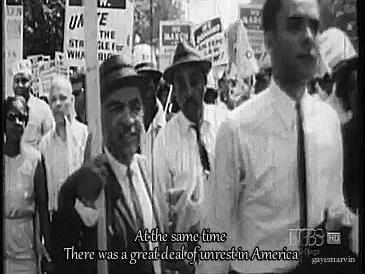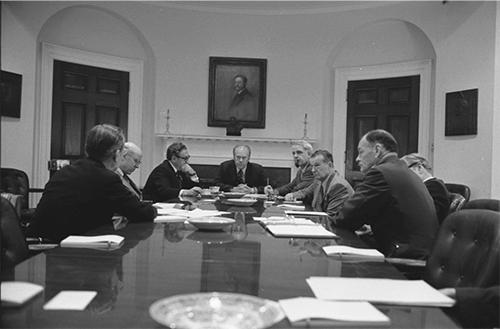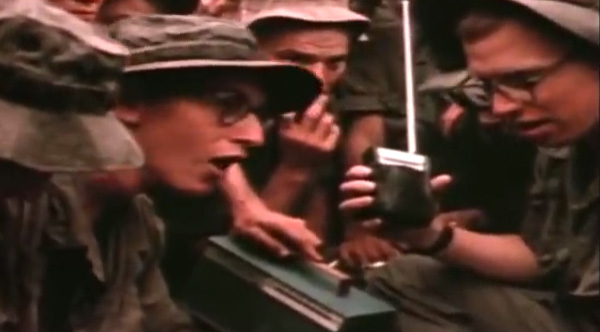Một trong những khuôn mặt bệnh hoạn đã từng bán đứng đồng đội, đất nước HK & trong đó có cả Miền Nam Việt Nam
Rare Historical Vietnam War Photos.
President Eisenhower preparing to address the nation in his iconic “Farewell Address.” January 17th, 1961
Vice President Lyndon B. Johnson meets with Vietnamese President Ngo Dinh Diem at Independence Palace, Saigon, as part of his Goodwill Tour of Southeast Asia. May 1961

Napalm air strikes raise clouds into gray monsoon skies above the Perfume River toward Hue in Vietnam. February 28th, 1963
A South Vietnamese Marine, severely wounded in a Viet Cong ambush, is comforted by a comrade in a sugar-cane field at Duc Hoa, about 12 miles from Saigon. August 5th, 1963
President John F. Kennedy (1961-1963) meets with U.S. Secretary of Defense (center) and U.S Army. Chief of Staff General Maxwell Taylor (left) prior to review their visit to South Vietnam to U.S. Military efforts. September 24th, 1963
As part of its winter-spring offensive, the Viet Cong sent its newly created 9th Division to attack South Vietnamese forces at Binh Gia. The attack lasted for 4 days and would eventually be broken by U.S. bombers. 1964
A low flying A-1 Skyraider drops 500 lb bombs on a Viet Cong stronghold. December 26th, 1964
As a symbol of protest in opposition to involvement in the Vietnam War, thousands of young American men began burning their draft cards. May, 1964.
A.G.I. talking to Vietnamese natives on the road while escorting a supply convoy. 1964
President Johnson (1963-1969) signed House Joint Resolution 1145, otherwise known as the Tonkin Gulf Resolution expanding the president’s authority to increase U.S. involvement in the war between North and South Vietnam. Johnson, and later Nixon, would go on to use the resolution as the legal rectification for their military policies in Vietnam. August 7th, 1964
Photo Of Viet Cong Leader, Ho Chi Minh (1964)
United States troops holding a photo of Ho Chi Minh, who organized the Viet Cong in the late 1950’s
“Beyond Vietnam: A Time to Break Silence” is an anti-Vietnam war and pro-social justice speech delivered by Martin Luther King Jr. The major speech at Riverside Church in New York, New York, followed several interviews and several other public speeches in which King came out against the war in Vietnam and the policies that increase the war. April 4th, 1967
Huey helicopters carrying troops of the U.S. 173rd Airborne Brigade get help landing on a road near the Montagnard village of Plei Ho Drong. August, 1965.
A Vietnamese mother and her children wade across a river, fleeing a bombing raid on Qui Nhon by United States aircraft. September 7th, 1965
The Viet Cong weren’t the only thing U.S. troops had to worry about in the jungle. Here is a marine holding a giant centipede. 1965
U.S. Helicopters Provide Cover (1965)
Hovering U.S. helicopters dump machine gun fire into the tree line to cover advancing South Vietnamese ground troops in to route attack a Viet Cong camp eighteen miles north of Tay Ninh. March, 1965
Fallen Soldiers (1965)
U.S. First Cavalry Air Mobile (1965)
Elements of the U.S. First Cavalry Air Mobile division in a landing craft approach the beach at Qui Nhon, 260 miles northeast of Saigon, Vietnam. September, 1965
Thousands attend a rally on the grounds of the Washington Monument to hear Ernest Gruening, a Democratic Senator from Alaska, and other speakers discuss U.S. policy in Vietnam. April 17th, 1965
U.S. jets dropping napalm on Viet Cong stronghold. 1965
South Vietnamese children, and a U.S. Soldier taking cover in a waterbed. 1965
Marines wade ashore with heavy equipment at first light at Red Beach near Da Nang. April 10th, 1965
Carpet Bombing (1965)
A U.S. B-52 stratofortress drops a load of 750-pounds bombs over a Vietnam coastal area during the Vietnam War. November 5th, 1965
In this 1966 propaganda commercial, Batman, played by actor Adam West, urged kids to buy government savings bonds to support the Vietnam War.
After being hit by enemy ground fire during Operation Hastings, just south of the Demilitarized Zone between North and South Vietnam. The helicopter crashed and exploded on a hill, killing one crewman and 12 Marines. July 15, 1966
Troops walk the Ho Chi Minh trail in the Truong Son Mountains, which form the 750-mile long spine of Vietnam, stretching across much of the country’s western border. 1966
Pedestrians cross the destroyed Hue Bridge in Hue, Vietnam. 1968
A U.S. Air Force Douglas A-1E Skyraider drops a white phosphorus bomb on a Viet Cong position in South Vietnam. 1966
The singing group the “Korean Kittens” appear on stage at Cu Chi, Vietnam, during the Bob Hope USO Christmas show, to entertain U.S. troops of the 25th Infantry Division. 1966
Wounded Marine Gunnery Sgt. Jeremiah Purdie (center, with bandaged head) reaches toward a stricken comrade after a fierce firefight south of the DMZ in Vietnam. October, 1966.
A U.S. Marine fires his M60 machine gun, concealed behind logs and resting in a shallow hole, during the battle against North Vietnamese regulars for Hill 484, just south of the demilitarized zone. October 10th, 1966
A napalm strike erupts in a fireball near U.S. troops on patrol in South Vietnam. 1966
Potable drinking water was a valued resource in the jungle. These U.S. troops take advantage of a storm by drinking rain water. 1966
Women and children crouch in a muddy canal as they take cover from intense Viet Cong fire at Bao Trai, about 20 miles west of Saigon. January 1st, 1966.
Another image of Napalm being dropped on a Viet Cong stronghold. 1966
Soldier of C company, 2nd battalion, 503rd infantry, 173rd airborne brigade. January 3rd, 1966
A U.S. paratrooper moves away after setting fire to a house on the bank of the Vaico Oriental River, 20 miles west of Saigon. January 4th, 1966
Protesters are rushed by guards as they attempt to breach a security line at the Pentagon. October, 1967.
Phuong Dinh Railroad Bypass Bridge Bombing (1967)
Empty artillery cartridges pile up at the artillery base at Suoi Da, some 60 miles northwest of Saigon, at the southern edge of War Zone C. March 8th, 1967.
Part of a crowd of pro-Vietnam War demonstrators hold up signs and American flags in support of U.S. policy in Vietnam in Wakefield, Massachusetts. October 29th, 1967.
With the United States at war in Vietnam, Ali refused to be inducted into the armed forces, saying “I ain’t got no quarrel with those Vietcong.” On June 20, 1967, Ali was convicted of draft evasion, sentenced to five years in prison, fined $10,000 and banned from boxing for three years. He stayed out of prison as his case was appealed and returned to the ring. October 26th, 1970
Lieutenant Commander Donald D. Sheppard, of Coronado, California, aims a flaming arrow at a bamboo hut concealing a fortified Viet Cong bunker on the banks of the Bassac River, Vietnam. December 8th, 1967
Several thousand participate in the Spring Mobilization to End the War, a network of mass demonstrations across the country in cities such as San Francisco and New York. It’s estimated that as many as 60,000 marched in San Francisco and 125,000 in New York. April 15th, 1967

A trooper of the U.S. 1st cavalry division aims a flamethrower at the mouth of cave in An Lao Valley in South Vietnam. April 14th, 1967
This standardized version of the Zippo boat had a crew of seven and could reach a top speed of approximately 8 knots. It was capable of carrying 1,350 gallons of compressed Napalm, which could be fired for just over 3 ½ minutes up to a distance of 300 metres, depending on conditions. 1967
Operation Pegasus, Spring, 1968, an American 1st Cavalry helicopter airlifts supplies into a marine outpost.
An immense network of underground tunnels located in the Chu Chi district of Ho Chi Minh city, Saigon. Part of a much larger network of tunnels that run through the country. They served as the Viet Cong’s base of operations for the 1968 Tet Offensive. 1968
The Tet Offensive was one of the largest military campaigns of the Vietnam War. Tet Offensive consisted of surprise attacks on civilian and military command and control centers by the Viet Cong against the South Vietnamese and United States Armed Forces. 1968
Both sides of the conflict meet face to face in the Mekong Delta, otherwise known as the Plain of Reeds. 1968
The first sergeant of A Company, 101st Airborne Division, guides a medivac helicopter through the jungle foliage to pick up casualties suffered during a five day patrol. April, 1968
U.S. Air Force bombs create a curtain of flying shrapnel and debris barely 200 feet beyond the perimeter of South Vietnamese ranger positions defending Khe Sanh during the siege of the U.S. Marine base. March, 1968
Philadelphia, PA, veterans demonstrate their opposition to the Vietnam War. 1968
M-48 Patton with mine rollers designed to detonate enemy explosives ahead of U.S. infantry. 1968
A helicopter full of Marines heading out on patrol lifts off the airstrip at the Khe Sanh combat base. June 27th, 1968
U.S. Marines pass a Catholic church as they patrol near Danang, Vietnam, during the Vietnam War. 1968
A wounded U.S. paratrooper grimaces in pain while waiting for medical evacuation at base camp in the A Shau Valley near the Laos border in South Vietnam during the Vietnam War. May 19th, 1969
Freedom And World Peace (1969)
Banners of appreciation from the Vietnamese decorate the dock at Danang where a farewell ceremony was held by the Vietnamese Government for departing Marines of the 1st Battalion 9th Regiment. July 14th, 1969
More than 500,000 people marched down Pennsylvania Ave. to demonstrate their opposition to the Vietnam War on November 15th, 1969.
President Richard Nixon (1969-1974) boards a helicopter joining with National Security Advisor Henry Kissinger following a meeting with U.S. troops from the 1st infantry division. This was Nixon’s only visit to Vietnam as President. July 30, 1969
In Washington D.C., veterans protest the fighting in Indochina by discarding their medals and uniforms over the fence at the U.S. Capitol.
U.S. Infantry Soldier calling a medic to check on his South Vietnamese Counterpart. 1969
A guerrilla paddling through a mangrove forest in the Mekong Delta. The forest had been de-foiled with Agent Orange, 1970.
Navy Seals practicing their shooting capabilities. 1970
President Richard Nixon (1969-1974) gave formal authorization to commit U.S. combat troops to cooperate with South Vietnamese units against communist sanctuaries in Cambodia. A wave of protests would follow, one demonstration would result in the notorious Kent State shootings, where Army National Guard troops killed four students. April 30, 1970
John Kerry Senate Hearing (1971)
John Kerry, who would later go on to run for President, and serve as Secretary of State (2017-2017) became a prominent critic of the Vietnam war after his return in 1969. Kerry won an early transfer out of the conflict due to his 3 purple hearts. He also won a silver star. 1971
Entertainment and Anti War Protest (1971)
Soldier separated from wife, looking at Playboy magazine. At the expense of Hugh Hefner, a full place advert was placed in the February edition of Playboy in 1971 which was written by the group Vietnam Veterans Against The War. 1971
Laotian guerrillas haul supplies by elephant and foot to NVA troops near Route 9 in southern Laos during South Vietnam’s attempted interdiction of the trail. 1971
A prominent theme of opposition to the Vietnam War, resistance to forced military conscription. 1971
Entertainer Sammy Davis Jr. performs for members of the 1st Cavalry Division (Airmobile) in an undisclosed location in Vietnam. February of 1972.
Co-founder of the Beatles, entertainer, John Lennon is one of histories most prominent anti war activists. He and his wife Yoko Ono are known for their famous “bed ins” and involvement in the organization of massive protests at the Democratic National Convention among other acts of deviance. Seen here giving his iconic “V” peace sign (V for Vietnam). 1971
An outpost on the Vietnam-Cambodia boarder equipped with poison punji stakes. Sharpened and hardened with fire, such booby traps were meant to wound enemy troops not kill.
South Vietnamese planes dropped a napalm bomb on Trang Bang, which had been attacked and occupied by North Vietnamese forces. A South Vietnamese Air Force pilot mistook the group for enemy soldiers and diverted to attack. Here soldiers and members of the international media look on at the June 8th, 1972 attack
Protesters demonstrating against the Vietnam War march toward MacArthur Park, Los Angeles. April 22nd, 1972
Wounded civilians and troops attempt to push their way aboard a South Vietnamese evacuation helicopter. June 25th, 1972
South Vietnamese troop dug in at Hai Van experiences an incoming enemy round. November 20th, 1972
Lowering U.S. Flag (1972)
As the U.S. Army base at Long Binn is turned over to the South Vietnamese Army, the American Flag is lowered. The base is located 12 miles north of Saigon. November 11th, 1972
Agent Orange (1961-1971)
An American POW talks though a barred door port to fellow POWs at a detention camp in Hanoi. 1973
While employed by the RAND Corporation, precipitated a national political controversy in 1971 when he released the Pentagon Papers, a top-secret Pentagon study of U.S. government decision-making in relation to the Vietnam War. Due to governmental misconduct and illegal evidence gathering, and the defense by Leonard Boudin and Harvard Law School professor Charles Nesson, Judge Byrne dismissed all charges against Ellsberg. May 11th, 1973
POW Reunited With Family (1973)
Released prisoner of war Lt. Col. Robert L. Stirm is greeted by his family at Travis Air Force Base in Fairfield, California. March 17th, 1973
Peace Talks (1973)
Four delegations sit at the table during the first signing ceremony of the agreement to end the Vietnam War. Clockwise, from foreground, delegations of the Unites States, the Provisonal Revolutionary Government of South Vietnam, North Vietnam and South Vietnam. January 27th, 1973
John S. McCain is escorted by Lt. Cmdr. Jay Coupe Jr. to Hanoi’s Gia Lam Airport after the POW was released. McCain is now a sitting senator in the United States Senate. March 14th, 1973
No Man Left Behind (1974)
Iconic image of U.S. Soldiers demonstrating how no man gets left behind. 1974
Riot police block the path of hundreds of anti government demonstrators who moved from suburban Saigon to the city center. October 31st, 1974
During the Vietnam War, women were tasked with doing jobs normally reserved for men. Here women can be seen hauling heavy fishing nets in the Mekong River, 1974.
U.S. Civilians in Saigon, 1975.
Combat boots litter the road on the outskirts of Saigon, abandoned by ARVN soldiers who shed their uniforms to hide their status. April 30th, 1975
Jane Fonda, Hanoi Jane (1975)
Actress Jane Fonda speaking at an anti-vietnam war conference in the Hague. She earned the nickname “Hanoi Jane.” January 1975
Evacuees (1975)
A CIA employee (probably O.B. Harnage) helps Vietnamese evacuees onto an Air America helicopter from the top of 22 Gia Long Street, a half mile from the U.S. Embassy. April 25, 1975
Evacuees board a boat in the Saigon waterfront as communist forces close in on the city. 1975
U.S. Navy personnel aboard the USS Blue Ridge push a helicopter into the sea off the coast of Vietnam in order to make room for more evacuation flights from Saigon. April 29th, 1975
U.S. Marines hit the deck of the USS Blue Ridge, to dodge flying metal from a South Vietnamese helicopter that crashed on the deck of the ship. 1975
Mobs of Vietnamese people scale the wall of the U.S. Embassy in Saigon, Vietnam, trying to get to the helicopter pickup zone, just before the end of the Vietnam War. April 29th, 1975
A North Vietnamese tank rolls through the gate of the Presidential Palace in Saigon, signifying the fall of South Vietnam. April 30th, 1975
Fall Of Saigon (1975)
The taking of Saigon marked the fall of the U.S.-backed south and the end to a decade of fighting. North Vietnamese troops run across the tarmac of Tan Son Nhat air base in Saigon as smoke billows behind abandoned U.S. Air Force transport planes. April 30th, 1975
Immediately after the U.S. Security forces vacated the U.S. embassy in Saigon, people began flocking to the embassy to loot it. There was a curfew in place that did not deter large crowds of people from cleaning out the complex of any useful supplies they could get their hands on. 1975

President Gerald Ford speaking at Tulane University in New Orleans, Louisiana, considered to be the first public announcement of the end of the Vietnam War. April 23rd, 1975
andy

Video:
▼
30 Tháng Tư Với Trần Quang Duật
▼
HEAR THE RADIO REPORT THAT THEY’RE GOING HOME

